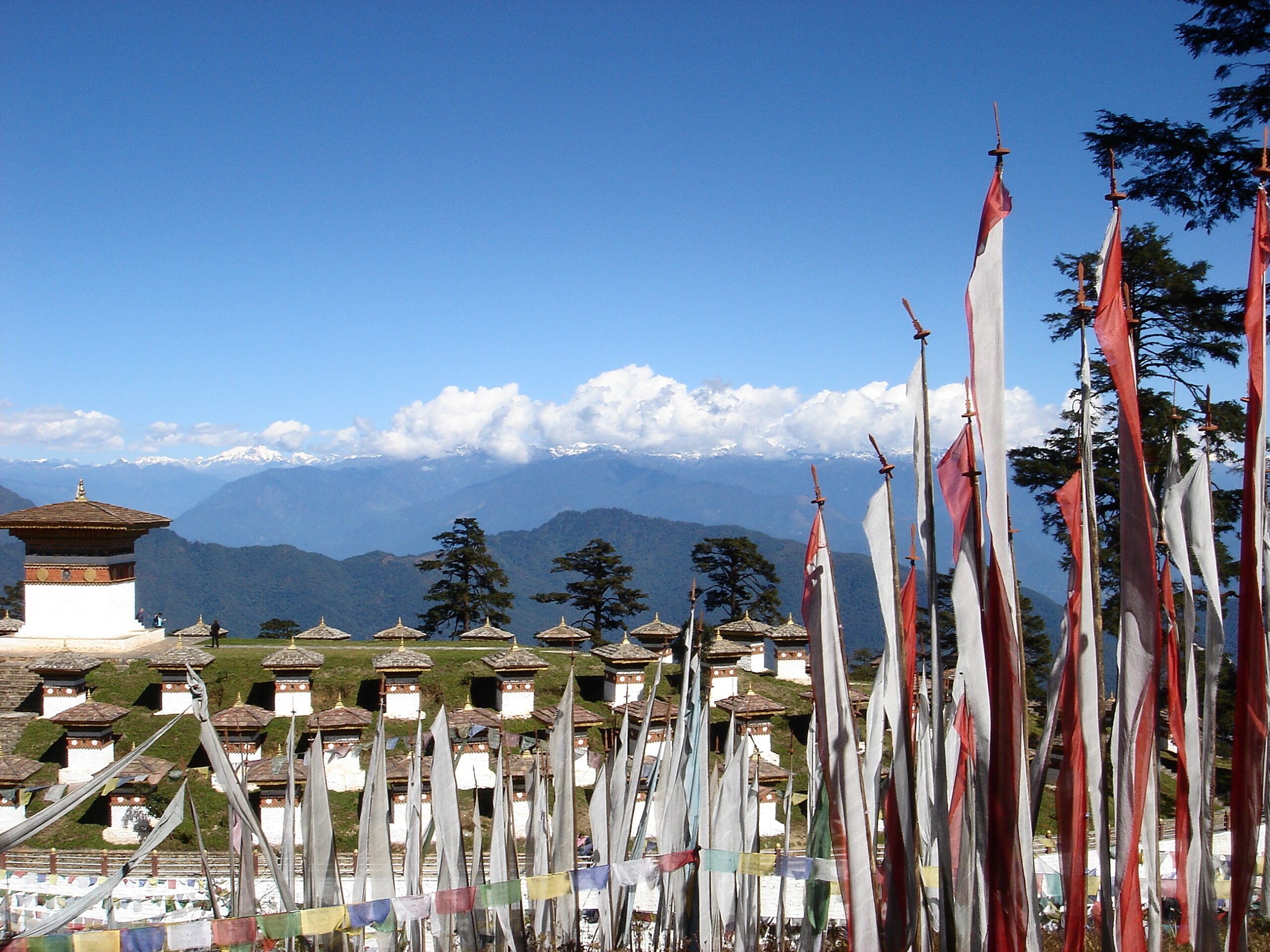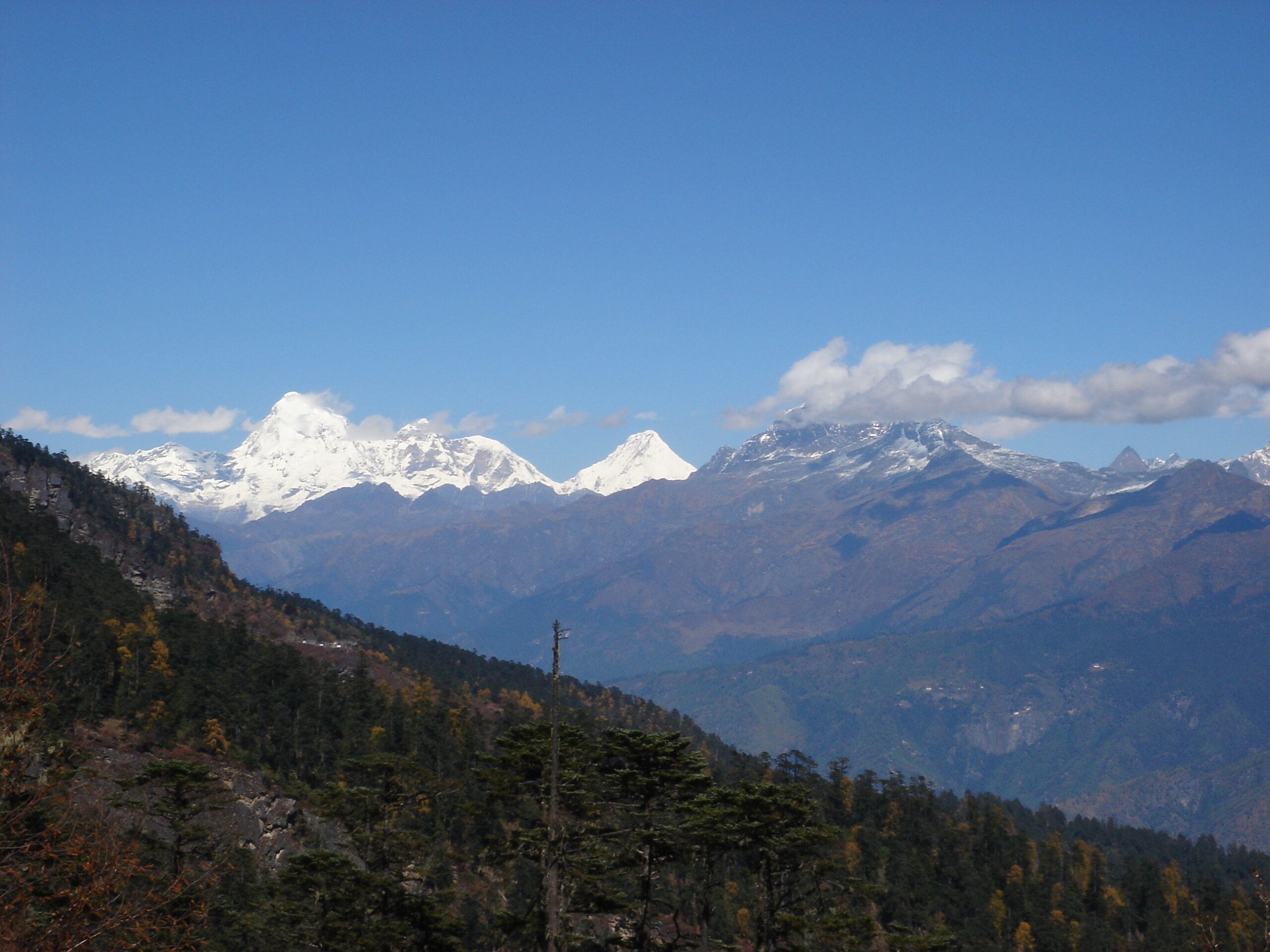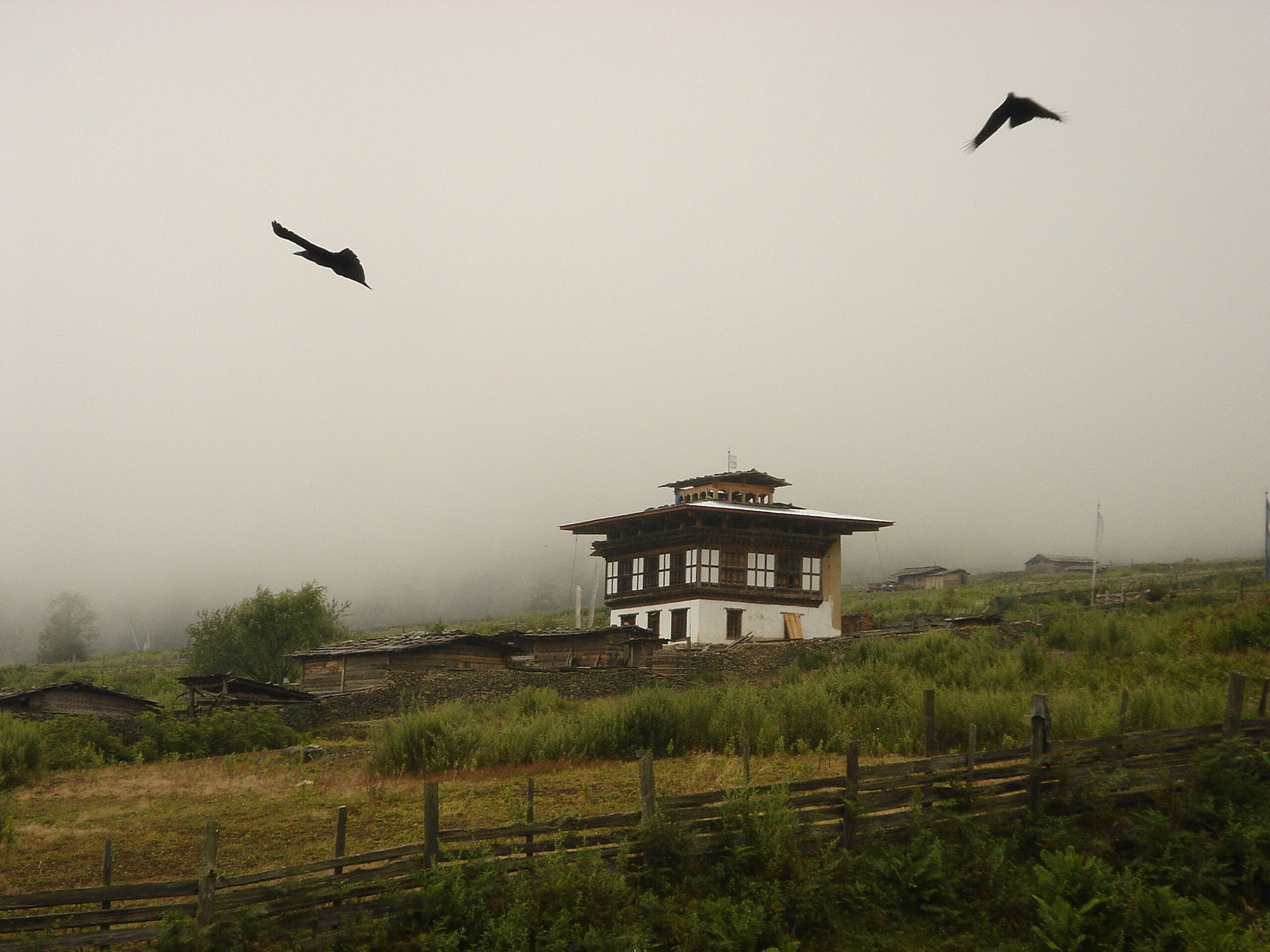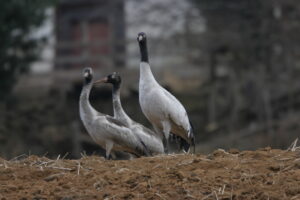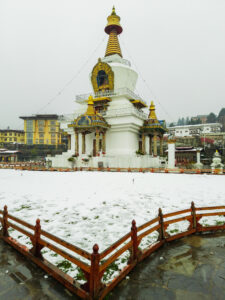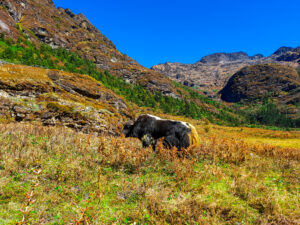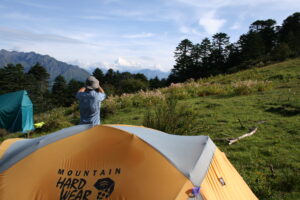At a Glance
Duration: 13 nights, 14 days
Group Size: up to 16 participants
Tour Grading: Moderate
Activity: Short Trek with Cultural and Heritage
Sights: Tiger’s Nest monastery, Punakha Dzong, Paro Dzong, Phobjikha Valley, Trongsa, Bumthang, Jambay, and Kurjey Lhakhang; National Museum; Thimphu Centenary Market; Kuenselphordang; Painting School of Arts and Crafts; Textile Museum; National Museum; Madman Temple; Jele Dzong; Jimilang Tsho; Phajoding Goemba.
Best Season: March through November
Trip Route: Paro – Thimphu – Punakha – Phobjikha – Bumthang – Punakha – Paro – Jele Dzong – Jangchulakha – Jimilangtsho – Simkota Tsho
The Druk Path Trek is also a fairly easy hike to undertake, as the distances between rest camps are fairly short. The trail takes you through forests of fir, blue pine, and dwarf rhododendrons at altitudes ranging between 2400 and 4200 m. On the third day, hikers will arrive at Jimiling Lake, whose crystal-clear waters are home to gigantic trout. This trek also offers hikers stunning views of Mt. Gangkar Puensum, the highest unscaled peak in the world. The best times to embark on the Druk Path Trek are between March and November.
Trip Highlights
• The only capital in the world without traffic lights
• Bhutan Postal Museum, Evolution of Communication Systems in Bhutan
• Phobjikha, the valley of the sacred Black-Necked Cranes
• Stunning views from the passes of Pele la and Yotong la
• The Vanguard of the Warriors, Trongsa Dzong (fortress), Ta (watchtower) Dzong
• Chimi Lhakhang, the temple of fertility
• Tiger’s Nest: an exhilarating task of 2 hours of climbing and another 1.5 hours of retrieving steps
• Jimilang Tsho, the trout lake; Simkota Tsho
• Phajoding Goemba
Day 1: Arrive in Paro, Drive to Thimphu
Paro to Thimphu 55km, 1.5hours
On arrival, drive for 20 minutes to Paro town (2300m). From here, walk to Paro Dzong, crossing the cantilever bridge. This 17th-century fortress will introduce us to the Bhutanese way of life.
Drive to Thimphu (2400 m), the nation’s capital. In Thimphu, check-in at the hotel and take a rest. Later, visit the Memorial Chorten (stupa), a monument built in memory of the Third King of Bhutan by the late Royal Grandmother Ashi Phuntsho Choden Wangchuk in 1974. It is also dedicated to world peace and prosperity. People from all walks of life circumambulate the chorten, but mostly we see those elderly people throughout the day hauling away at a room-size giant prayer wheel right next to the entrance.
In the evening, visit Tashichho Dzong, – in its present incarnation, was consecrated as late as 1969, and this building is a visual delight. Unlike other Dzongs, this ‘peacetime’ one has three entrances: one for the common folk, leading to the administrative establishment; another to the monastic section in whose courtyard Tsechu has performed annually; and the third only for royalty.
Overnight in the hotel.
Day 2: Thimphu Sightseeing
Folk Heritage Museum, The restored three-story timber building replicates a traditional farmhouse and gives a pure glimpse into rural Bhutanese life and its households. To maintain our knowledge of indigenous natural resources, native trees and plants that had domestic uses in a rural Bhutanese household are grown, creating an oasis of greenery right in the heart of the capital city of Thimphu.
The National Textile Museum, under the royal patronage of the youngest Queen Mother, Ashi Sangay Choden Wangchuck, preserves the national textile and helps women's empowerment. They help women from the central and eastern parts of Bhutan through weaving. The museum also focuses on royal ghosts, including the wedding clothes worn by the fourth king and his four wives.
Centenary Farmers’ Market, every Saturday and Sunday, most of the Thimphu population congregates on the banks of the river, where the weekend market is held. Here, villages from the valley and other nearby villages come to sell their agricultural products.
Afternoon: visit the Post Office Museum and make customized stamps. The museum was established in November 2015 to commemorate the 60th birthday of the fourth King. The museum tells a story about Bhutan’s development and progress over time. Methods such as anecdotes, artifacts, and the rich assortment of stamps the country has developed are used.
Jungzhi Paper Factory tree barks of Daphne and Dhekap are used to make this traditional paper. You could indulge in the whole process and try making souvenirs of your own. The paper was originally used by monasteries for manuscripts and prayer books.
In the evening, drive to Kuensel Phodrang, Buddha Point. This 169-foot bronze statue of Buddha Dordenma, Vajra Throne Buddha, symbolizes indestructibility. The view of Thimphu Valley from this point is spectacular and beautiful, especially at night.
Overnight in the hotel.
Day 3: Phobjikha
After breakfast in the hotel, the drive to Punakha takes approximately 3 hours, with a stop at Dochula Pass, 3080 m above sea level, for the stunning view of the Bhutanese Himalayas.
Continue driving to Gagtey (Phobjikha Valley) via Wangdue Valley for 2 more hours. En route, stop at Wangdue to visit the huge Dzong (fortress; renovation is now going on) built in the shape of a sleeping bull. From Wandue, we drive uphill, almost crossing over Pele La, passing 3400m. Before reaching the pass, the road diverges and we take the road least traveled. This eventually leads to the ‘hidden valley’ containing the stunningly beautiful monastery of Gangtey Gompa. This lovely temple sits on top of a conical hill in the middle of the valley, with a small township nestling at the foot of the hill. It is normally possible to look around the inner courtyards and meet some of the monks. The valley is also home to the famous black cranes that migrate in the winter from Tibet. This lovely valley is situated on the western slopes of the Black Mountains and is designated a conservation area.
Overnight in the hotel.
Day 4: Bumthang
Phobjikha to Bumthang: 175 km, 4.5-hour drive
In the morning, drive to Pelela Pass and continue through stunning views of Trongsa, wander around Tongsa township, and visit the huge and historical Trongsa Dzong and the watchtower above the main Dzong. It has a fine temple at the top, containing the original Mongol armor, and a large prayer wheel outside.
Afternoon drive to Bumthang for 3 hours. En route, cross over Yotong La 11,234′, then descend into a place called Gaytsa, where you will be taken to visit Domkhar Tashicholing Monastery. It is 15–20 minutes’ walk from the road to the monastery. Walk back to the transport and continue to drive to Chumey Valley, the first of four Bumthang valleys. In Chumey, visit Yathra weaving (colorful wool weaving). From Chumey, it is another one-hour drive to Jakar, the center of the Bumthang valleys.
Bumthang Valley is considered one of the most sacred in the kingdom, and innumerable legends surround the area. It is here that the kings were cremated, and the present royal families trace their ancestry back to a famous saint called Pemalingpa, who was also a smith in Jakar Township.
Overnight in the hotel.
Day 5: Bumthang Sightseeing
After breakfast, start the walk from the hotel to Jambay Lhakhang (temple) and continue to Kurjey Lhakhang. After Kurjey, you will cross the suspension bridge over to Tamshing Lhakhang. Continue walking to the Swiss farm and then on to the main town area. The vehicle will meet you at this point and drive you to visit other sights in and around Jakar; which may include the homeopathic hospital, the cheese factory, the castle of the ‘White Bird’, perhaps one or two local temples, and a walk around to visit woodcraft workshop, dying workshop, and the five waterwheels behind Wangdicholing Old Palace
Overnight in the hotel.
Day 6: Bumthang to Punakha
From the township of Jakar, you first climb out of the Bumthang valleys on the twisting mountain road towards Yotong La (11,000 ft/3,353 m). Near the pass is an area of wild cane or bamboo that is a well-known habitat for the red panda. The road then descends to Tongsa, but instead of stopping here for the night, you will drive on, past Chendebji Stupa, over the Pele La (11,000 feet/3,353 meters), and start the descent until you reach your hotel located on the bank of the river.
Overnight in the hotel.
Day 7: Paro
Paro, originally one of the most beautiful valleys in the country, has Bhutan’s only airport located here, among the terraced fields, and elegant farmhouses. Willow trees line many of the roads, contrasting with the bright colors of the fields, and the most popular and important sites are also found within the Paro district. Paro town (2,280m), locally called 'Tshongdu', is still small, with just two main streets and less than two hundred small family-run shops. The weekend market in Paro is held on Sundays in a small area near the town.
Paro Rinphung Dzong was consecrated in 1645 by Shabdrung Nawang Namgyal on the site of the smaller fort. Throughout the 17th and 18th centuries, it served as a bastion against invasion from the north. It is regarded as one of the finest examples of Bhutanese architecture, with intricate woodwork, and large beams slotted into each other and held together without nails. It houses the giant 30m X 45m Thangka (Thongdrol), commissioned in the mid-18th century, displayed on the last day of the Paro Tsechu festival. Rinphung Dzong is the district headquarters of Paro and the residence of state monks under Paro Rabdey.
Dungtse Lhakhang was constructed by the great bridge-builder Thangtong Gyelpo in 1433. It is said to have been built on the head of the demon, who was causing illness to the inhabitants. The building was restored in 1841 and is a unique repository of Kagyu lineage arts. You may or may not be permitted inside, but you can walk around this three-story Chorten-type building.
National Museum of Bhutan, Established in 1967, the museum is housed inside a circular Ta Dzong, an ancient watchtower. It has a fascinating collection of arts, relics, religious Thangka paintings, household pieces of stuff, arms, handicrafts, stuffed animals, and Bhutan’s famous stamps, among others (open 10-4 pm, closed on Monday).
Overnight in the hotel.
Day 8: Paro (Half-Day Excursion to Tiger’s Nest)
Spend the day hiking to the famous Taktsang monastery. Lunch is at the tea house near Taktsang. Depending on your interests and abilities, you may explore other sites around Taktsang, which include Zangdopelri and Ugyen Tshemo.
Hike to Taktsang is a steep uphill and takes from 2 hours to 4 hours, depending on how high you want to get and want to see. The return trek is downhill and takes about half the time. Return to Paro in the evening.
Overnight in the hotel.
Day 9: Jele Dzong (trek starts)
4 to 5 trek to Jele Dzong
Your pack ponies arrive at the starting point of the trek, near the museum area. The trek begins around 10 am after the horsemen and trekking crews have packed your luggage and trekking supplies in order. To begin, the trail passes through some villages, houses, apple orchards, cultivated fields, steadily uphill. Then trek through the blue pine and fir forests, with some nice meadows and a great view of Paro Valley, as you climb to the camping grounds near Jele Dzong at an altitude of approximately 3500m.
Overnight in a tent.
Day 10: Jangchulakha
4 to 5 hours Trek to Jangchulakha
Jele Dzong is atop a promontory at an altitude of 3560m, which is a short ascent from your camp. On a clear day, the great views of Paro town and the upper valley far below and Mt. Chomolhari, Mt Jitchu Drake, and adjoining peaks can be seen in the distance. Visit this remote temple/fortress. From the Dzong, the trek is a long gradual ridge walk in a rhododendron forest. You descend and climb through forests of spruce, cedars, and other trees mostly ravaged by bark beetles. You may pass the nomadic yak herders camps, and see some beautiful flora and fauna including monal pheasants. Camp at a pasture land at an altitude of approximately 3750m.
Overnight in a tent.
Day 11: Jimilangtsho
6 to 7 hours Trek to Jimilangtsho Lake
The trail follows the ridge, ascending and descending as you get the view of the mountains and valley are beautiful. The campsite is close to the lake Jimilangtso at an altitude of 3870m. These lakes are known for their giant sized trout and if lucky you may enjoy a freshly prepared lake trout for dinner.
Overnight in a tent.
Day 12:Simkota Tsho
4 to 5 hours of trekking to Simkota Tsho (lake)
The trek makes gradual climbs and descends, with the highest point being 4150m. The trail takes you through dwarf rhododendron trees and the lake of Janetso. You may come across some yak herders camps where you will have the opportunity to get a glimpse of a nomad's life. The campsite is close to Simkota Lake.
Overnight in a tent.
Day 13: Trek Ends in Thimphu
The trek makes several short ascents, to seemingly summits, traverses a broad rocky valley, some sky burial sites, and crosses the final ridge at Phume la pass (4100m). From the pass, on a clear day, you will have a spectacular view of Mount “Gangkhar Punsum," the highest mountain in Bhutan, as well as other peaks and the view below of the entire Thimphu valley. From the pass, descend and visit the Thujidra Gompa, a meditation site, that hangs on the side of the precipitous rock face at 3950m. A short but steep descent from here is your campsite near the stone shelter at an altitude of 3750m. Phajoding has several meditation residences and some ancient temples. The last day of your trek is all the way downhill through the forested area of mostly blue pine. At a leisurely pace, it takes about three hours from Phajoding. While you are waiting for the trekking crew and mules to arrive, explore the mini zoo nearby for Takin, the national animal of Bhutan.
Overnight in the hotel.
Day 14 — International Departure
After an early morning breakfast, depending on the flight schedule, drive to Paro International Airport for departure to onward destination and bid farewell.

